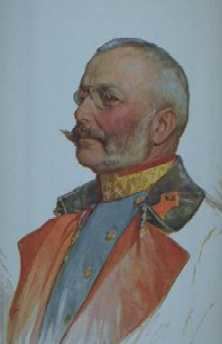Reign 1895–1918 House House of Lorraine Name Archduke Duke | Predecessor Albrecht | |
 | ||
Issue Maria Christina, Hereditary Princess of Salm-SalmMaria Anna, Princess Elias of Bourbon-ParmaMaria Henrietta, Princess Gottfried of Hohenlohe-Waldenburg-SchillingfurstArchduchess Natalie MariaArchduchess Stephanie Maria IsabelleArchduchess Gabriele Maria TheresiaIsabella, Princess Georg of BavariaMaria Alice, Baroness von BassenheimArchduke Albrecht Franz, Duke of Teschen Spouse Princess Isabella of Croy (m. 1878–1931) Children Archduke Albrecht Franz, Duke of Teschen Parents Archduke Karl Ferdinand of Austria, Archduchess Elisabeth Franziska of Austria Similar People Princess Isabella of Croy, Archduke Charles - Duke of T, Archduke Eugen of Austria, Archduke Albrecht Franz - Du, Archduchess Isabella of Austria | ||
Archduke Friedrich, Duke of Teschen (Friedrich Maria Albrecht Wilhelm Karl; 4 June 1856 – 30 December 1936) was a member of the House of Habsburg and the Supreme Commander of the Austro-Hungarian Army during World War I.
Contents
Early life
Friedrich was born at the castle Gross-Seelowitz (now Židlochovice, near Brno in Moravia) the son of Karl Ferdinand, Archduke of Austria and his wife Archduchess Elisabeth Franziska of Austria.
His siblings included Queen Maria Cristina of Spain, Archduke Charles Stephen of Austria, a candidate for the Kingdom of Poland, and Archduke Eugen of Austria, and Austrian officer.
When Friedrich's uncle Archduke Albert, Duke of Teschen died in 1895, he and his brothers each inherited large estates. Friedrich owned properties at Ungarisch-Altenburg (now Mosonmagyaróvár in Hungary), Belleje, Saybusch (now Żywiec in Poland), Seelowitz (now Židlochovice) and Frýdek in the Czech Republic, and Pressburg (now Bratislava in Slovakia). His Vienna residence, the Palais-Albrecht, housed the Albertina art collection which he owned.
Marriage
On 8 October 1878 Friedrich married at Château L'Hermitage in Belgium, Princess Isabella of Croÿ (1856–1931), daughter of Rudolf, Duke of Croÿ, and his wife Princess Natalie of Ligne. They had nine children together.
Military career
Like most of the princes of the ruling house, Friedrich adopted a military career, and served creditably for many years as commandant of the V. (Pressburg) Corps. Subsequently, commander-in-chief of the Austrian Landwehr (militia) and army inspector, he became, after the murder of the heir to the throne, Archduke Franz Ferdinand, inspector-general of the Austro-Hungarian Army.
In World War I, he was —from the dynastic point of view —as grandson of the victor of Aspern, Archduke Charles, and as nephew of the victor of Custoza, Archduke Albert, the predestined head of the armed forces of Austria-Hungary; and on 11 July 1914 Friedrich was appointed supreme commander of the Austro-Hungarian Army by Emperor Franz Joseph I. He thought it his duty to accept this heavy responsibility, but, modestly estimating his own powers, left the actual exercise of the command to his chief-of-staff, Franz Graf Conrad von Hötzendorf. In the performance of ceremonial duties, and as mediator for the settlement of the conflicting demands of the military, civil and allied elements, his services were undeniable. He was promoted to the rank of Generalfeldmarschall on 8 December 1914. In February 1917 Emperor Charles himself took over the supreme command; the Archduke, although the Emperor's representative, no longer appeared in the foreground.
Retirement and death
After World War I the governments of Austria and Czechoslovakia confiscated all of Friedrich's properties within their borders. These included his palace in Vienna and his art collection. He retained his properties in Hungary however. In 1929 he won a court case requiring compensation from the Czechoslovak government.
Friedrich died at Ungarisch-Altenburg (Magyaróvár, now Mosonmagyaróvár) in 1936. His death was the biggest royal event for Hungary since the coronation of King Karl in 1916. The funeral and burial in the Pfarrkirche in Mosonmagyaróvár was attended by his nephew, the exiled King of Spain; by numerous archdukes; by all the surviving Austro-Hungarian field marshals; by personal representatives of Hitler; by members of the House of Savoy; by the diplomatic corps; by a son of exiled German Kaiser Wilhelm; by representatives of the governments of Germany, Italy and Austria, and by Hungary's Regent, Miklós Horthy and his wife. There were members of the Hungarian government and delegates of the German and Austrian in attendance as well. Entire battalions of the Hungarian army were present to pay their last respects to their former Supreme Commander.
